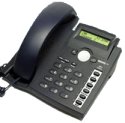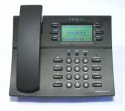Linux based IP telephones
Sep 28, 2000 — by LinuxDevices Staff — from the LinuxDevices Archive — 256 viewsThis LinuxDevices Quick Reference Guide includes pointers to our coverage of IP telephones that run embedded Linux. For Linux-based mobile phones and smartphones, click here.
 Snom m3 — Mar. 03, 2008 — Berlin-based Snom's Linux-based cordless VoIP phones now include the its first cordless model, the m3. Adhering to the DECT standard for cordless phones, the m3 offers an indoor range of 50 meters, an outdoor range of 100 meters, and a claimed 10 hours of talk time.
Snom m3 — Mar. 03, 2008 — Berlin-based Snom's Linux-based cordless VoIP phones now include the its first cordless model, the m3. Adhering to the DECT standard for cordless phones, the m3 offers an indoor range of 50 meters, an outdoor range of 100 meters, and a claimed 10 hours of talk time.
 Sophia Systems Sandgate 3-P — Sep. 21, 2007 — This handheld IP phone hardware reference design from Sophia Systems is based on a Marvell PXA310 (“Monahans-LV”) processor clocked at 624MHz. The Sandgate 3-P runs Linux, including Trolltech's Qtopia Phone Edition, and is equipped with 128MB of RAM, 256MB of flash (expandable via a MicroSD slot), WiFi, Bluetooth, a W-SIM card slot, and a 2.2-inch QVGA (640×480) LCD.
Sophia Systems Sandgate 3-P — Sep. 21, 2007 — This handheld IP phone hardware reference design from Sophia Systems is based on a Marvell PXA310 (“Monahans-LV”) processor clocked at 624MHz. The Sandgate 3-P runs Linux, including Trolltech's Qtopia Phone Edition, and is equipped with 128MB of RAM, 256MB of flash (expandable via a MicroSD slot), WiFi, Bluetooth, a W-SIM card slot, and a 2.2-inch QVGA (640×480) LCD.
 SysMaster Tornado M20 — Jun. 15, 2007 — SysMaster's Linux-based four-line IP (Internet protocol) video phone offers built-in PBX capabilities, requiring no central SIP server to make or receive calls within a LAN. The Ethernet- and WiFi-enabled Tornado M20 is based on a TI RISC/DSP processor, and can either output video or audio content to attached audio/video equipment, or play back multimedia content on its built-in 3.5-inch screen.
SysMaster Tornado M20 — Jun. 15, 2007 — SysMaster's Linux-based four-line IP (Internet protocol) video phone offers built-in PBX capabilities, requiring no central SIP server to make or receive calls within a LAN. The Ethernet- and WiFi-enabled Tornado M20 is based on a TI RISC/DSP processor, and can either output video or audio content to attached audio/video equipment, or play back multimedia content on its built-in 3.5-inch screen.
 Iwatsu NR-IPKTV — Feb. 13, 2007 — This Iwatsu Electric Co. IP videophone lets users place calls by selecting numbers from web pages using Opera Software's Opera for Devices browser, along with an email client. The Linux-based NR-IPKTV business phone is one component of Iwatsu's Precot (Premium Communication Tool) product, an all-inclusive VoIP package for small offices.
Iwatsu NR-IPKTV — Feb. 13, 2007 — This Iwatsu Electric Co. IP videophone lets users place calls by selecting numbers from web pages using Opera Software's Opera for Devices browser, along with an email client. The Linux-based NR-IPKTV business phone is one component of Iwatsu's Precot (Premium Communication Tool) product, an all-inclusive VoIP package for small offices.
 Philips Visiophone VP6000 — Jan. 18, 2007 — This Philips Consumer Electronics WiFi videophone sports a 2.2-inch QCIF+ (176×220) TFT LCD. The Visiophone VP6000 and its earphone-jack- and TV-out-equipped sibling, the VP6500, run Linux on an ARM9-based Freescale i.MX21 processor, and feature vendor-initiated firmware updates.
Philips Visiophone VP6000 — Jan. 18, 2007 — This Philips Consumer Electronics WiFi videophone sports a 2.2-inch QCIF+ (176×220) TFT LCD. The Visiophone VP6000 and its earphone-jack- and TV-out-equipped sibling, the VP6500, run Linux on an ARM9-based Freescale i.MX21 processor, and feature vendor-initiated firmware updates.
 Belkin WiFi Phone — Dec. 12, 2006 — A WiFi phone based on Linux and Skype's proprietary VoIP (voice-over-IP) client, the Belkin WiFi Phone for Skype can use open or encrypted WiFi networks, and connects seamlessly at commercial hotspots and hot zones operated by Boingo, Belkin says.
Belkin WiFi Phone — Dec. 12, 2006 — A WiFi phone based on Linux and Skype's proprietary VoIP (voice-over-IP) client, the Belkin WiFi Phone for Skype can use open or encrypted WiFi networks, and connects seamlessly at commercial hotspots and hot zones operated by Boingo, Belkin says.
 Skype/Philips VoIP841 — Sep. 1, 2006 — Skype on Aug. 31 introduced a pair of cordless VoIP phones, one of which is based on a Philips design that runs Linux. The VoIP841 comes with a DECT-compliant basestation that attaches directly to broadband and POTS lines.
Skype/Philips VoIP841 — Sep. 1, 2006 — Skype on Aug. 31 introduced a pair of cordless VoIP phones, one of which is based on a Philips design that runs Linux. The VoIP841 comes with a DECT-compliant basestation that attaches directly to broadband and POTS lines.
 ASC Telecom Marathon EvoLite phone recorder — Aug. 1, 2006 — A Linux-based communications server offering hybrid VoIP (voice-over-IP) and TDM (time-division multiplexing) recording capabilities, the Marathon EvoLite is the first available communications recorder based on embedded Linux, the Rotkreuz-based company claims.
ASC Telecom Marathon EvoLite phone recorder — Aug. 1, 2006 — A Linux-based communications server offering hybrid VoIP (voice-over-IP) and TDM (time-division multiplexing) recording capabilities, the Marathon EvoLite is the first available communications recorder based on embedded Linux, the Rotkreuz-based company claims.
 Snom 300 — Apr. 1, 2006 — A basic model in Snom's line of Linux-based business VoIP (voice-over-IP) phones, the Snom 300 supports six lines, and has six programmable buttons, along with a browser interface. It targets small offices, call centers, lobbies, recreation centers, and more.
Snom 300 — Apr. 1, 2006 — A basic model in Snom's line of Linux-based business VoIP (voice-over-IP) phones, the Snom 300 supports six lines, and has six programmable buttons, along with a browser interface. It targets small offices, call centers, lobbies, recreation centers, and more.
 KPN VP5500 — Jan. 23, 2006 — A Linux-powered cordless videophone available in the Netherlands, the VP5500 uses “established standards-based technologies like WiFi and Linux,” the Dutch telecom service provider says. The phone will become available elsew in Europe in 2006, according to consumer electronics giant Philips, manufacturer of the device.
KPN VP5500 — Jan. 23, 2006 — A Linux-powered cordless videophone available in the Netherlands, the VP5500 uses “established standards-based technologies like WiFi and Linux,” the Dutch telecom service provider says. The phone will become available elsew in Europe in 2006, according to consumer electronics giant Philips, manufacturer of the device.
 Zultys WIP2 cordless VoWiFi phone — Aug. 5, 2005 — A Linux-powered handheld VoWiFi phone that looks, acts, and operates like a conventional cordless office telephone, but lets mobile users roam within an office.
Zultys WIP2 cordless VoWiFi phone — Aug. 5, 2005 — A Linux-powered handheld VoWiFi phone that looks, acts, and operates like a conventional cordless office telephone, but lets mobile users roam within an office.
 Snom 320 — Jun. 3, 2005 — A Linux-based VoIP (voice-over-IP) business phone said to offer high-quality conferencing, thanks to on-phone bridging and a full-duplex speakerphone.
Snom 320 — Jun. 3, 2005 — A Linux-based VoIP (voice-over-IP) business phone said to offer high-quality conferencing, thanks to on-phone bridging and a full-duplex speakerphone.
 Siemens OptiPoint WL2 Professional — May. 2, 2005 — A Linux-based 802.11b/g Wi-Fi cordless phone compatible with SIP and CorNet IP protocols, the OptiPoint resembles a normal phone with a large screen.
Siemens OptiPoint WL2 Professional — May. 2, 2005 — A Linux-based 802.11b/g Wi-Fi cordless phone compatible with SIP and CorNet IP protocols, the OptiPoint resembles a normal phone with a large screen.
 Snom 360 — Feb. 3, 2005 — The Linux-powered Snom 360 is described as a secure, SIP-based business phone with excellent audio quality, programmability, and ease of use, thanks to hardware buttons for critical audio and call functions. The 360 supports the SRTP (secure real-time transport protocol) and SIPS (SIP secure) standards, which are recommended by the IETF (Internet engineering task force) for protection against eavesdropping and data theft.
Snom 360 — Feb. 3, 2005 — The Linux-powered Snom 360 is described as a secure, SIP-based business phone with excellent audio quality, programmability, and ease of use, thanks to hardware buttons for critical audio and call functions. The 360 supports the SRTP (secure real-time transport protocol) and SIPS (SIP secure) standards, which are recommended by the IETF (Internet engineering task force) for protection against eavesdropping and data theft.
 Voipac Network Phone NP 210 — Nov. 5, 2004 — The Voipac Net Phone (NP) 210 is an H323.v4-compatible IP phone that can also do Instant Messaging, email, Web conferencing, and more. The phone was created by Voipac, formerly Levi Systems, an eight-year-old company based in Slovakia that also sells USB phones, softphones and softswitches, VoIP servers, and IP phones, as well as CPU modules.
Voipac Network Phone NP 210 — Nov. 5, 2004 — The Voipac Net Phone (NP) 210 is an H323.v4-compatible IP phone that can also do Instant Messaging, email, Web conferencing, and more. The phone was created by Voipac, formerly Levi Systems, an eight-year-old company based in Slovakia that also sells USB phones, softphones and softswitches, VoIP servers, and IP phones, as well as CPU modules.
 Snom 190 — Sep. 22, 2004 — An inexpensive Linux-based VoIP (voice over IP) phone that supports the latest security standards, making it “practically impossible” to tap VoIP calls when used with another standards-compliant VoIP endpoint, the Berlin-based company says. The Snom 190 targets business users.
Snom 190 — Sep. 22, 2004 — An inexpensive Linux-based VoIP (voice over IP) phone that supports the latest security standards, making it “practically impossible” to tap VoIP calls when used with another standards-compliant VoIP endpoint, the Berlin-based company says. The Snom 190 targets business users.
 Amstrad E3 — Sep. 21, 2004 — Amstrad has used embedded Linux to build an inexpensive videophone. The approximately $180 Amstrad E3 enables users to send email and SMS/MMS messages, surf the Web, and videoconference with other E3 users over a 56K modem connection to a UK service provider.
Amstrad E3 — Sep. 21, 2004 — Amstrad has used embedded Linux to build an inexpensive videophone. The approximately $180 Amstrad E3 enables users to send email and SMS/MMS messages, surf the Web, and videoconference with other E3 users over a 56K modem connection to a UK service provider.
 Snom 220 — Aug. 12, 2004 — Snom has released a Linux-based VoIP phone for small- and medium-sized enterprises. The “high-end affordable” Snom 220 offers international language support, including Asian languages, and many advanced features such as 16-bit audio, call waiting indication, call intrusion, call divert, call park, call pick-up, music-on-hold, and more.
Snom 220 — Aug. 12, 2004 — Snom has released a Linux-based VoIP phone for small- and medium-sized enterprises. The “high-end affordable” Snom 220 offers international language support, including Asian languages, and many advanced features such as 16-bit audio, call waiting indication, call intrusion, call divert, call park, call pick-up, music-on-hold, and more.
 NexGen City NexPaq — May. 6, 2004 — NexGen City has embedded Linux into the first VoIP (voice over internet protocol) push-to-talk (PTT) handset for emergency workers and “first responders.” The “NexPaq” is currently undergoing testing in the first NexLink mesh network, which is nearing completion in Garland, Texas. The Garland network covers 57 square miles, and is the first deployment of mobile mesh networking technology for use by a public safety organization, according to NexGen.
NexGen City NexPaq — May. 6, 2004 — NexGen City has embedded Linux into the first VoIP (voice over internet protocol) push-to-talk (PTT) handset for emergency workers and “first responders.” The “NexPaq” is currently undergoing testing in the first NexLink mesh network, which is nearing completion in Garland, Texas. The Garland network covers 57 square miles, and is the first deployment of mobile mesh networking technology for use by a public safety organization, according to NexGen.
 Zultys ZIP 4×4 — Mar. 25, 2003 — Now shipping, this IP phone is based “100% percent on open technologies,” including Linux. The device is said to be compatible with any IP telephony system using SIP (Session Initiation Protocol), with support for advanced features such as line-rate Ethernet switching, voice encryption, and five-way conferencing.
Zultys ZIP 4×4 — Mar. 25, 2003 — Now shipping, this IP phone is based “100% percent on open technologies,” including Linux. The device is said to be compatible with any IP telephony system using SIP (Session Initiation Protocol), with support for advanced features such as line-rate Ethernet switching, voice encryption, and five-way conferencing.
 Panasonic broadband terminal / IP-phone — Jan. 8, 2003 — This device connects to the Internet and has an integrated LCD/touchscreen display. The unit doubles as a phone with features such as message answering, number display, and ring melody selection.
Panasonic broadband terminal / IP-phone — Jan. 8, 2003 — This device connects to the Internet and has an integrated LCD/touchscreen display. The unit doubles as a phone with features such as message answering, number display, and ring melody selection.
 InnoMedia IP VideoPhone — Dec. 2, 2002 — The MTA 3368 IP VideoPhone is equipped with a 4-inch color TFT LCD, has the look and feel and ease of use of an ordinary telephone, and is capable of delivering real-time high quality video images at up to 768 Kbps bandwidth. Support is included for SIP, MGCP, and H.323, as well as QoS mechanisms such as VLAN and ToS settings.
InnoMedia IP VideoPhone — Dec. 2, 2002 — The MTA 3368 IP VideoPhone is equipped with a 4-inch color TFT LCD, has the look and feel and ease of use of an ordinary telephone, and is capable of delivering real-time high quality video images at up to 768 Kbps bandwidth. Support is included for SIP, MGCP, and H.323, as well as QoS mechanisms such as VLAN and ToS settings.
 snom 100 VoIP phone — May. 15, 2002 — This device supports various open telephony standards including SIP, H.323/H.450, and Asterisk, as well as data protocols like HTTP, TAPI, and LDAP. Inside, t's a Motorola PowerQUICC processor with 16MB of RAM running a Linux 2.4.18 kernel.
snom 100 VoIP phone — May. 15, 2002 — This device supports various open telephony standards including SIP, H.323/H.450, and Asterisk, as well as data protocols like HTTP, TAPI, and LDAP. Inside, t's a Motorola PowerQUICC processor with 16MB of RAM running a Linux 2.4.18 kernel.
 hippo Internet Phone — May. 7, 2002 — The hippo Internet Phone's embedded computer is based a 48MHz Motorola MPC850/823 PowerPC system-on-chip processor with 16MB of DRAM, running an Embedded Linux operating system.
hippo Internet Phone — May. 7, 2002 — The hippo Internet Phone's embedded computer is based a 48MHz Motorola MPC850/823 PowerPC system-on-chip processor with 16MB of DRAM, running an Embedded Linux operating system.
 Aplio/PRO IP Phone — Aug. 9, 2000 — Aplio's Internet phone is a compact speakerphone-like appliance that contains uClinux running on an Aplio/TRIO system-on-chip processor. Internal memory consists of 4MB of RAM plus a 2MB flash disk, and the Internet connection is made via either a built-in modem or Ethernet (hub) function (depending on model).
Aplio/PRO IP Phone — Aug. 9, 2000 — Aplio's Internet phone is a compact speakerphone-like appliance that contains uClinux running on an Aplio/TRIO system-on-chip processor. Internal memory consists of 4MB of RAM plus a 2MB flash disk, and the Internet connection is made via either a built-in modem or Ethernet (hub) function (depending on model).
This article was originally published on LinuxDevices.com and has been donated to the open source community by QuinStreet Inc. Please visit LinuxToday.com for up-to-date news and articles about Linux and open source.